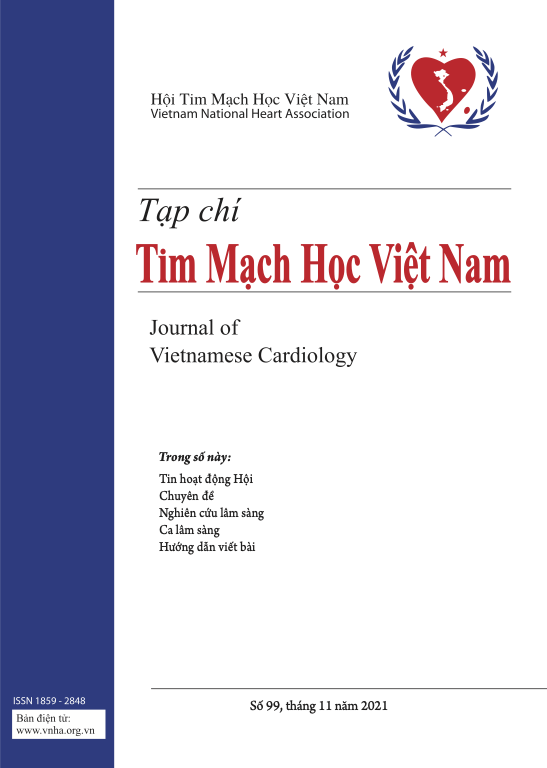Các yếu tố ảnh hưởng đến sử dụng thuốc bám sát hướng dẫn điều trị hội chứng vành cấp
Tóm tắt
Đặt vấn đề: Sử dụng thuốc bám sát hướng dẫn điều trị (HDĐT) giúp giảm tử vong và chi phí.
Mục tiêu nghiên cứu:Xác định yếu tố ảnh hưởng sử dụng thuốc bám sát HDĐT hội chứng vành cấp (HCVC).
Đối tượng và phương pháp nghiên cứu:Thực hiện nghiên cứu cắt ngang trên bệnh nhân (BN) HCVC tại Cần Thơ năm 2015. Thực hiện hồi quy logistic đa biến để xác định các yếu tố.
Kết quả: 610 BN được chọn. Khi nhập viện, bác sĩ ít kê đơn kết hợp bốn nhóm thuốc được khuyến cáo cho BN suy tim (OR 0,53; 95%CI 0,30-0,94); nhưng thường kê cho BN tăng huyết áp (OR 28,4; 95%CI 3,5-185,4). Khi xuất viện, bác sĩ ít kê kết hợp bốn nhóm thuốc cho BN suy tim (OR 0,47; 95%CI 0,31-0,71) và tuổi ≥65 (OR 0,67; 95%CI 0,46-0,98); nhưng thường kê cho BN HCVC có ST chênh lên (OR 1,49; 95%CI 1,02-2,19) và được can thiệp mạch vành qua da (OR 2,29; 95%CI 1,46-3,61).
Kết luận: Việc chỉ định thuốc ít bám sát HDĐT ở BN HCVC cao tuổi và có suy tim mắc kèm nên được nghiên cứu đánh giá thêm.
Từ khoá: hội chứng vành cấp, yếu tố ảnh hưởng, hướng dẫn điều trị, Cần Thơ
Tài liệu tham khảo
1. Benjamin EJ, Blaha MJ, Chiuve SE, et al (2017), “Heart Disease and Stroke Statistics-2017 Update: A Report From the American Heart Association”, Circulation 135(10):e146-e603.
![]()
2. Dugani S, Gaziano TA et al (2016), “25 by 25: Achieving Global Reduction in Cardiovascular Mortality”,
![]()
Curr Cardiol Rep 18(1):10-015-0679-4.
![]()
3. World Health Organization (2017), “The top 10 causes of death”, Available at: http://www.who.int/ mediacentre/factsheets/fs310/en/#.V3Zz37Hy82I. Accessed April/14, 2017.
http://www.who.int/ mediacentre/factsheets/fs310/en/#.V3Zz37Hy82I. Accessed April/14, 2017.">
![]()
4. Nguyen VL, et al (2010), “Nghiên cứu mô hình bệnh tật ở bệnh nhân điều trị nội trú tại Viện tim mạch Việt Nam trong thời gian 2003-2007”, Journal of Vietnamese Cardiology 52:11-18 [Vietnamese].
![]()
5. Peterson ED, Roe MT, Mulgund J, at al (2006), “Association between hospital process performance and outcomes among patients with acute coronary syndromes”, J Am Med Assoc 295(16):1912-1920.
![]()
6. Shimony A, Grandi SM, Pilote L, et al (2014), “Utilization of evidence-based therapy for acute coronary syndrome in high-income and low/middle-income countries”, Am J Cardiol 113(5):793-797.
![]()
7. Yan AT, Yan RT, Tan M, et al (2007), “Optimal medical therapy at discharge in patients with acute coronary syndromes: temporal changes, characteristics, and 1-year outcome”, Am Heart J 154(6):1108-1115.
![]()
8. Redfern J, Hyun K, Chew DP, et al (2014), “Prescription of secondary prevention medications, lifestyle advice, and referral to rehabilitation among acute coronary syndrome inpatients: results from a large prospective audit in Australia and New Zealand”, Heart 100(16):1281-1288.
![]()
9. Berwanger O, Guimaraes HP, Laranjeira LN, et al (2012), “Effect of a multifaceted intervention on use of evidence-based therapies in patients with acute coronary syndromes in Brazil: the BRIDGE-ACS randomized trial”, JAMA 307(19):2041-2049.
![]()
10. Sleight P (2000), “The HOPE Study (Heart Outcomes Prevention Evaluation)”, J Renin Angiotensin Aldosterone Syst 1(1):18-20.
![]()
11. Kassab YW, Hassan Y, Aziz NA, et al (2013), “Use of evidence-based therapy for the secondary prevention of acute coronary syndromes in Malaysian practice”, J Eval Clin Pract 19(4):658-663.
![]()
12. Bainey KR, Armstrong PW, Fonarow GC, et al (2014), “Use of renin-angiotensin system blockers in acute coronary syndromes: findings from Get With the Guidelines-Coronary Artery Disease Program”, Circ Cardiovasc Qual Outcomes 7(2):227-235.
![]()
13. Jernberg T, Hasvold P, Henriksson M, et al (2015), “Cardiovascular risk in post-myocardial infarction patients: nationwide real world data demonstrate the importance of a long-term perspective”, Eur Heart J 36(19):1163-1170.
![]()
14. Lee JH, Yang DH, Park HS, et al (2010), “Suboptimal use of evidence-based medical therapy in patients with acute myocardial infarction from the Korea Acute Myocardial Infarction Registry: prescription rate, predictors, and prognostic value”, Am Heart J 159(6):1012-1019.
![]()
15. Tra J, van der Wulp I, Appelman Y, et al (2015), “Adherence to guidelines for the prescription of secondary prevention medication at hospital discharge after acute coronary syndrome: a multicentre study”, Neth Heart J 23(4):214-221.
![]()
16. Al-Zakwani I, Zubaid M, Panduranga P, et al (2011), “Medication use pattern and predictors of optimal therapy at discharge in 8176 patients with acute coronary syndrome from 6 Middle Eastern countries: data from the gulf registry of acute coronary events”, Angiology 62(6):447-454.
![]()








